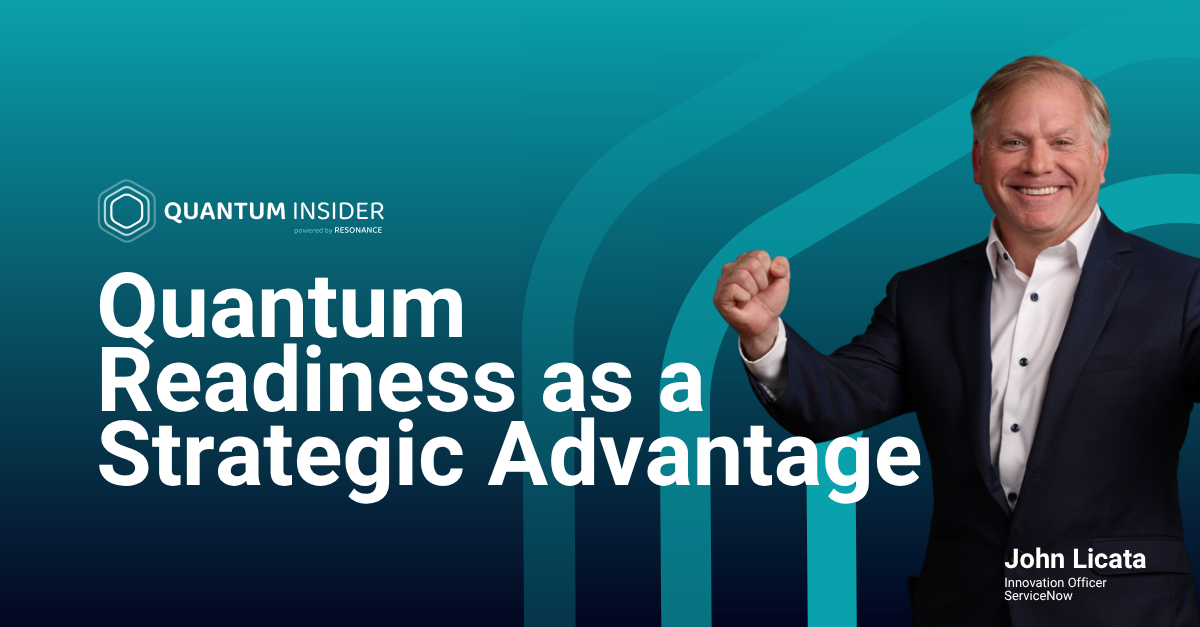Insider Brief:
- Quantum computing is emerging as a powerful disruption that could accelerate discovery, strengthen supply chains, and challenge current encryption systems.
- Leading enterprises such as JPMorgan, Volkswagen, HSBC, and Telefónica are already testing quantum applications in finance, logistics, and cybersecurity.
- The ServiceNow Quantum Readiness Innovation Brief warns that migrating to quantum-safe systems means early action is essential to protect data and digital trust.
- The brief outlines four pillars, including leadership, centers of excellence, workforce literacy, and strategic roadmapping, as the foundation for enterprise resilience and competitiveness in the quantum era.
Most executives can anticipate a disruption they can see. The real challenge is preparing for one that develops piecewise across laboratories, research networks, and global policy tables long before it reaches the market. Quantum computing is that kind of disruption, and one that has the potential to accelerate drug discovery, strengthen supply chains, and undermine the encryption systems that protect essential infrastructure. Overall, it is a technology that most organizations would be wise to prepare for proactively.
Such is the premise for ServiceNow’s latest Quantum Readiness Innovation Brief, authored by John Licata, Innovation Officer at ServiceNow, which argues that the time for business leaders to begin planning is now. Quantum technologies are developing gradually but decisively, with applications emerging across finance, medicine, national security, and logistics. The question is whether organizations are ready to adapt before those changes become unavoidable.
The First Signs of Impact
For decades, businesses have embraced technology as a means of efficiency. Mainframes, the internet, mobile, cloud computing, and most recently artificial intelligence all promised productivity gains and fresh avenues for growth. Quantum computing follows the same trajectory of potential but with a deeper implication as it challenges the very assumptions on which today’s digital infrastructure is built.

Early NISQ-era systems, operating in the range of a few dozen to a few hundred qubits, have begun to test quantum’s unique capabilities. Hardware providers are now pushing toward fault-tolerant architectures, with ambitions to scale to one million qubits. At that threshold, problems once considered computationally impossible such as simulating molecules with precision or optimizing global logistics in real time move within reach.
While many executives are still acclimating to the disruptions of generative AI, others are already running their own quantum pilots in production-like environments. Financial institutions are experimenting with faster portfolio optimization. Pharmaceutical companies are testing molecular simulations to accelerate drug development. Telecommunications and cybersecurity firms are exploring quantum-secure communication networks resistant to interception.
JPMorgan, for instance, is working with Argonne National Laboratory to test algorithms for portfolio optimization, an area where classical systems struggle under the weight of countless variables. In the automotive sector, Volkswagen has piloted projects with D-Wave to optimize bus routes in Lisbon, showing how quantum systems might improve logistics at the scale of an entire city. HSBC recently partnered with IBM to explore quantum’s potential in risk modeling. And Telefónica, as the ServiceNow Quantum Readiness Innovation Brief notes, has embedded quantum readiness directly into its operations by creating a dedicated Center of Excellence to strengthen cybersecurity, enhance communications, and explore new customer-facing services.
Taken together, these efforts speak to how quantum exploration is beginning to integrate into business strategy.
Digital Trust on Borrowed Time
If experimentation defines quantum’s opportunities, security defines its risks. The same properties that make quantum computing powerful for optimization and discovery also make it capable of breaking the cryptographic foundations of today’s digital infrastructure.
Governments have begun preparing for a “post-quantum” era, where existing encryption standards could be rendered obsolete. In 2024, the U.S. National Institute of Standards and Technology (NIST) even released a new suite of post-quantum cryptography standards.
As the ServiceNow Quantum Readiness Innovation Brief emphasizes, migration to quantum-safe systems is an urgent imperative. It cannot happen overnight. Replacing vulnerable algorithms across a global enterprise takes years of planning, coordination, and testing. The danger lies in delay. Adversaries may already be using “harvest now, decrypt later” strategies to collect encrypted data today with the expectation that it will be decrypted once quantum systems mature.
The trust of customers, the protection of intellectual property, and the integrity of national infrastructure all depend on acting before that moment arrives. Quantum readiness, therefore, is not only an innovation strategy but a matter of digital resilience.
A Strategic Imperative
Innovation and security are often discussed as separate agendas, but in quantum, they converge. The same forces that are developing applications for use in chemistry, logistics, and finance are also affecting the foundations of digital trust.
As John Licata, Innovation Officer at ServiceNow, notes, “For enterprise leaders, this means preparing to harness quantum’s exponential potential, not just for speed, but for solving problems classical AI can’t touch. Embedding quantum into AI workflows opens new frontiers in decision-making, security, and resilience. The C-suite must lead this shift now, ensuring their organizations are not just ready for the quantum era, but positioned to shape it.”

Across the global technology ecosystem, the potential of quantum computing, is often discussed in these broad lenses of innovation and risk. What remains less common are tangible, actionable instructions for how enterprises can prepare. The ServiceNow Quantum Readiness Innovation Brief steps into that gap, providing a practical framework that translates anticipation into strategy and awareness into execution. The brief distills readiness into actionable pillars:
- Leadership and Coordination: Appointing a dedicated quantum lead or cross-functional task force ensures that experimentation, investment, and governance stay aligned across business units.
- Centers of Excellence: Establishing a central hub for quantum research, partnerships, and pilot projects allows organizations to move beyond isolated experiments and toward coherent strategy.
- Workforce and Literacy: Building quantum literacy through education, training, and collaboration with academia reduces the knowledge gap that often slows adoption of new technologies.
- Strategic Roadmapping: Developing a prioritized roadmap of quantum use cases connects long-term potential to near-term value creation, ensuring that exploration supports measurable business outcomes.
These are not abstract recommendations, but rather concrete actions enterprises can begin implementing today. As the brief makes clear, readiness is less about predicting the exact moment quantum advantage arrives and more about building the structures that allow an organization fluidity when it does.
Notably, this work demands leadership. Quantum readiness cannot rest solely with the chief technology officer. Financial leaders must plan for long-term capital allocation. Compliance officers must prepare for evolving standards. Human resources must anticipate new skill sets and roles. Even marketing and communications teams play a role in shaping the narrative that builds stakeholder trust.
Quantum readiness, in this sense, is both a business strategy and a form of risk management, and overall, an investment in resilience that spans every corner of the enterprise.
The Leadership Imperative
The ServiceNow Quantum Readiness Innovation Brief closes on a clear message: quantum readiness is not a luxury, but a responsibility. The opportunity and the threat are two sides of the same coin. To protect data, ensure resilience, remain competitive, and open new avenues of growth, enterprises must act before the technology matures, not after.
Quantum computing will not arrive all at once. Its influence will become apparent unevenly, first through niche pilots, then through material shifts in security standards, and finally through large-scale commercial adoption. The organizations that lead through that dynamic trajectory will be those that commit to readiness as an ongoing discipline.
As the brief highlights, readiness goes beyond defensive posture. It is a route to unmatched operational resilience, new revenue models, and a first-mover advantage in the industries that quantum will eventually redefine. The steps outlined, establishing leadership, building literacy, and developing quantum-safe infrastructure are the foundation of enterprise strategy in a changing reality.
Business leaders now face a choice to wait for clarity and risk being defined by others’ momentum, or to prepare proactively, embedding quantum into strategy, governance, and investment today. The difference between those paths will be measured in resilience, trust, and the ability to lead through uncertainty.
To explore how quantum readiness can translate into measurable business outcomes, connect with John Licata, Innovation Officer at ServiceNow, to discuss what this looks like practice.

















